-
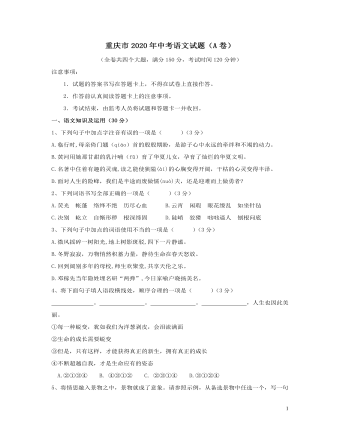
2020年重庆市中考语文试卷(A)及答案
每个人或多或少都会有一定的负面情赌,处于青春期的中学生也不例外。考场失利、友谊翻船、同学嘲笑、父母唠叨……都有可能使你陷入控败、沮丧、愤怒、厌烦等负面情绪中。这些情绪如果得不到及时疏导,就有可能爆发,不同程度地影响人际关系。
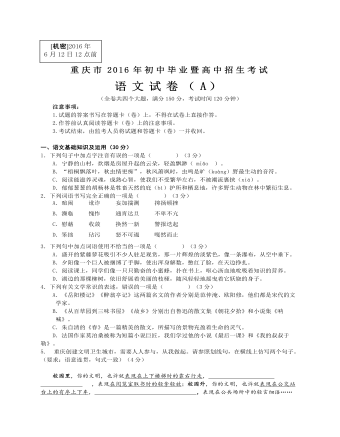
2016年重庆市中考语文试卷(A)及答案
朋友说,只那一句,就让她打开了心扉。并不是因为女生真的变得和她一样,而是女生眼中的真诚与失落。对于朋友来说,刹那间那真诚深切的目光,像温暖的手,轻轻地叩开了心里那扇冷漠的门。
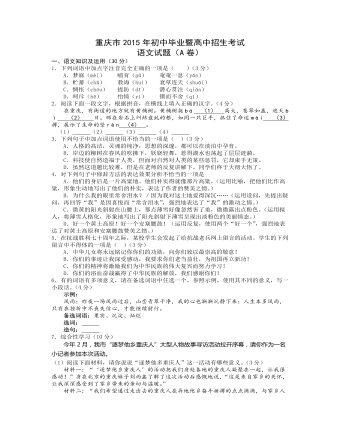
2015年重庆市中考语文试卷(A)及答案
中国人习惯于将“天”“地”“人”三个字并列,“天”与“地”就是人的“水土”。我们可以想象一下,没有高山、没有河流、没有原野、没有草木,我们无处获取木料、种植粮食、接来饮水,人怎么去生活?“水土”不仅给我们自然的凭靠,也给我们心灵的慰藉,比如看到天空之远,我们会放飞梦想的翅膀
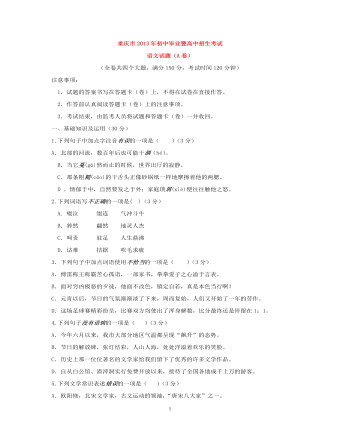
2013年重庆市中考语文试卷(A)及答案
越是寒冷的天气,雪花落得越勤。其实,一生最寒冷的际遇中,总会凝结出一些直入人心的美好。冬季并不能将一切冻结,比如那些流淌的风,料峭的树,比如那些些酸涩而充满希望的心,都会在冰封雪地中生机盎然。
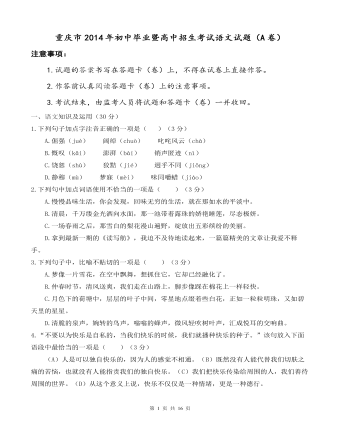
2014年重庆市中考语文试卷(A)及答案
自三峡七百里中,两岸连山,略无阙处。重岩叠嶂,隐天蔽日,自非亭午夜分,不见曦月。至于夏水襄陵,沿溯阻绝。或王命急宣,有时朝发白帝,暮到江陵,其间千二百里,虽乘奔御风,不以疾也。
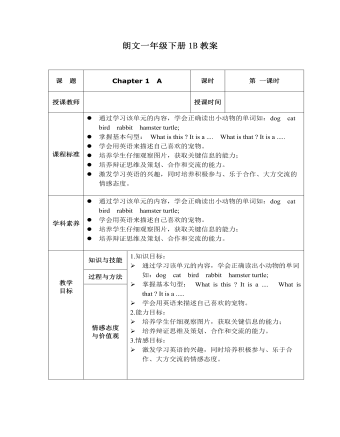
一年级朗文下册1B 教材 Chapter 1 A
l 通过学习该单元的内容,学会正确读出小动物的单词如:dog cat bird rabbit hamster turtle;l 掌握基本句型: What is this ? It is a .... What isthat ? It is a .....l 学会用英语来描述自己喜欢的宠物。l 培养学生仔细观察图片,获取关键信息的能力;l 培养辩证思维及策划、合作和交流的能力。l 激发学习英语的兴趣,同时培养积极参与、乐于合作、大方交流的情感态度。
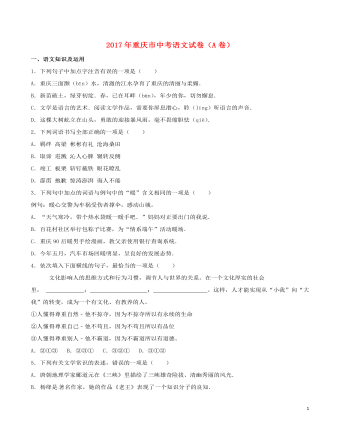
重庆市2017年中考语文真题试题(A卷,含解析)
①喜欢书,像喜欢一件宝物。小时每每发了新书,都要找来旧报纸,包了书皮,工工整整写上:语文,数学……然后是班级姓名。手里托着书,美滋滋看着,心里有份庄重。有种没来由的稳妥。②学期末,新书变旧书,一如既往的整齐,只是有了岁月的痕迹,泛着淡淡的黄。细心收起来,放到纸箱里,来年春天,再搬出来晒太阳。③偶然去老师家,一进门就呆住了:老师客厅的一面墙,宽宽大大一面架子,大大小小的书,一本本直立着,是一队队意气风发的少年,春意荡漾啊!罗列其中的,还有照片,石膏雕像,或者一盆小小的文竹……我真是看呆了,书,可以这样放,多好!
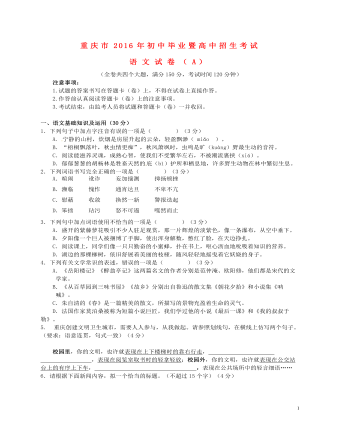
重庆市2016年中考语文真题试题(A卷,含答案)
医学研究证明,笑具有激活人体某些基因的功能。人们通常认为,基因是恒定不变的。但事实上很多基因常常处于休眠状态,或者没有积极地制造蛋白质,通过某种形式的刺激,可以把它们唤醒,笑就是其中一种刺激。
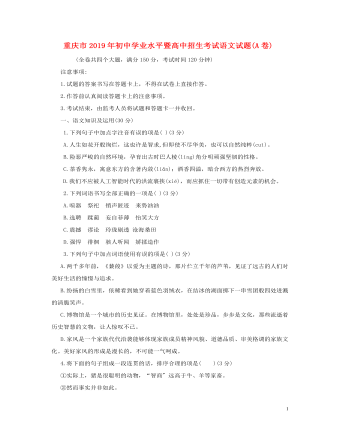
重庆市2019年中考语文真题试题(A卷)
我送三婶到大门口,对她说谢谢。三婶说,咱不说远亲近邻,我懂你妈的心思。我知道她舍不下老家。庄稼人走到哪里,其实根都牢牢扎在老家的土里。另外,我给你们钥匙,还有一个原因。还记得你在家的时候,经常问我为什么总带着一把老钥匙吗?我的老家在遥远的山里,是土房子,因为一场突来的泥石流,房子没有了,但母亲一直让我们自个儿保存着属于自己的那把老钥匙。想家的时候,我就看看老钥匙,摸摸老钥匙,想象着转动钥匙打开门锁,爹娘兄妹啊,那些熟悉的物件啊,一下子呼啦啦在眼前演电影,心里就热乎乎的,就连当初的一些懊恼、吵闹都成了好。你们想回来看看的时候就回来,这里啥时候都是你们的家。
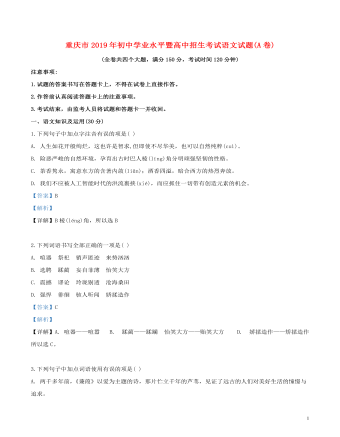
重庆市2019年中考语文真题试题(A卷,含解析)
小石潭记柳宗元从小丘西行百二十步,隔篁竹,闻水声,如鸣珮环,心乐之。伐竹取道,下见小潭,水尤清冽。全石以为底,近岸,卷石底以出,为坻,为屿,为嵁,为岩。青树翠蔓,蒙络摇缀,参差披拂。潭中鱼可百许头,皆若空游无所依,日光下澈,影布石上。佁然不动,俶尔远逝,往来翕忽。似与游者相乐。潭西南而望,斗折蛇行,明灭可见。其岸势犬牙差互,不可知其源。坐潭上,四面竹树环合,寂寥无人,凄神寒骨,悄怆幽邃。以其境过清,不可久居,乃记之而去。同游者:吴武陵,龚古,余弟宗玄。隶而从者,崔氏二小生:曰恕己,曰奉壹。
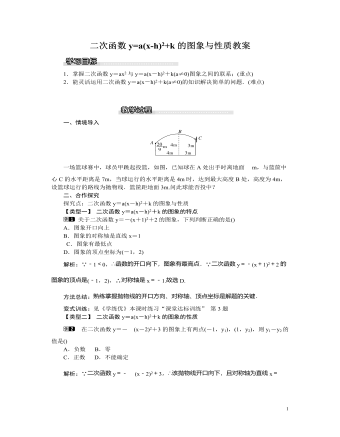
北师大初中九年级数学下册二次函数y=a(x-h)2+k的图象与性质1教案
(3)设点A的坐标为(m,0),则点B的坐标为(12-m,0),点C的坐标为(12-m,-16m2+2m),点D的坐标为(m,-16m2+2m).∴“支撑架”总长AD+DC+CB=(-16m2+2m)+(12-2m)+(-16m2+2m)=-13m2+2m+12=-13(m-3)2+15.∵此二次函数的图象开口向下,∴当m=3米时,“支撑架”的总长有最大值为15米.方法总结:解决本题的关键是根据图形特点选取一个合适的参数表示它们,得出关系式后运用函数性质来解.三、板书设计二次函数y=a(x-h)2+k的图象与性质1.二次函数y=a(x-h)2+k的图象与性质2.二次函数y=a(x-h)2+k的图象与y=ax2的图象的关系3.二次函数y=a(x-h)2+k的应用要使课堂真正成为学生展示自我的舞台,还学生课堂学习的主体地位,教师要把激发学生学习热情和提高学生学习能力放在教学首位,为学生提供展示自己聪明才智的机会,使课堂真正成为学生展示自我的舞台.充分利用合作交流的形式,能使教师发现学生分析问题、解决问题的独到见解以及思维的误区,以便指导今后的教学.
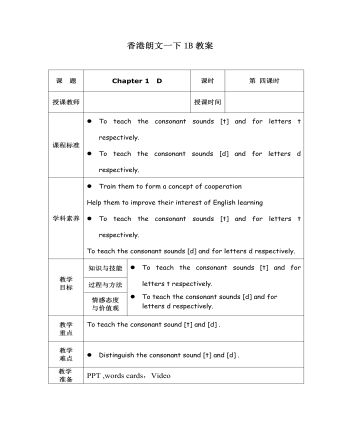
一年级朗文1A Chapter 1 D
l To teach the consonant sounds [t]and for letters t respectively.To teach the consonant sounds [d] and for letters d respectively.
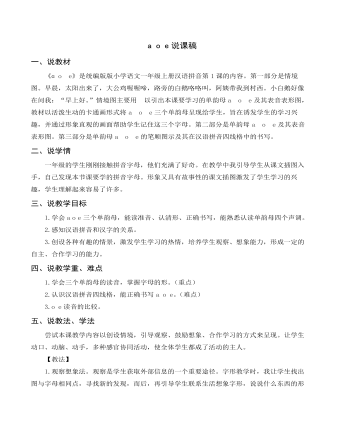
《a o e》说课稿
1.认清形。我们再来看看“a”(出示表音表形图)它不光发音和“阿姨”的“阿”差不多,她的样子,像什么?2.小结:“a”圆圆的,就像阿姨的脸,后面还拖着一条直直的小辫子呢!能记住“a”了吗?你觉得 a还像什么?
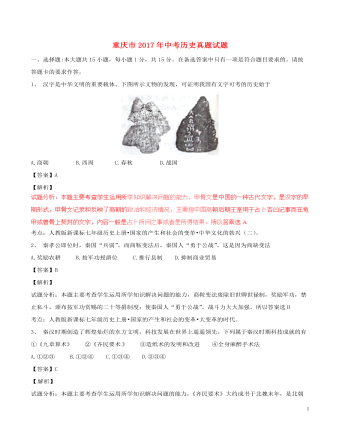
重庆市2017年中考历史真题试题(A卷,含解析)
1)观察下图,请将下列地点的英文字母代号填入答题卡图中对应的方框内。(2分)A.20世纪80年代设置的对外开放的窗口:深圳经济特区。B.20世纪90年代设置的扩大开放的窗口:上海浦东新区(2)河北雄安新区是继深圳经济特区和上海浦东新区之后又一具有全国意义的新区,目的之一,是打造扩大开放的新高地。仔细观察该图并结合设置时间,指出上述三区设置的特点。(1分)
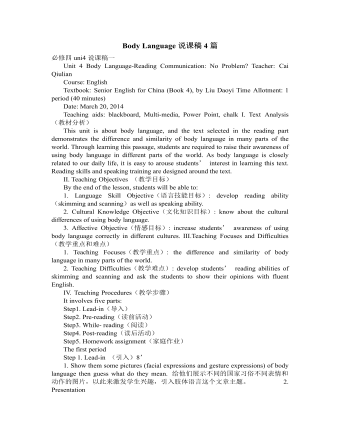
人教版高中英语必修4Body Language说课稿4篇
Textbook: Senior English for China (Book 4), by Liu Daoyi Time Allotment: 1 period (40 minutes)Date: March 20, 2014Teaching aids: blackboard, Multi-media, Power Point, chalk I. Text Analysis (教材分析)This unit is about body language, and the text selected in the reading part demonstrates the difference and similarity of body language in many parts of the world. Through learning this passage, students are required to raise their awareness of using body language in different parts of the world. As body language is closely related to our daily life, it is easy to arouse students’ interest in learning this text. Reading skills and speaking training are designed around the text.II. Teaching Objectives (教学目标)By the end of the lesson, students will be able to:1. Language Skill Objective(语言技能目标): develop reading ability (skimming and scanning)as well as speaking ability.2. Cultural Knowledge Objective(文化知识目标): know about the cultural differences of using body language.3. Affective Objective(情感目标): increase students’ awareness of using body language correctly in different cultures. III.Teaching Focuses and Difficulties(教学重点和难点)1. Teaching Focuses(教学重点): the difference and similarity of body language in many parts of the world.2. Teaching Difficulties(教学难点): develop students’ reading abilities of skimming and scanning and ask the students to show their opinions with fluent English.
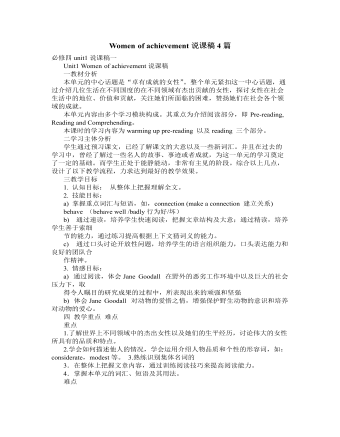
人教版高中英语必修4Women of achievement说课稿4篇
Good morning, distinguished judges:It’s my honor to talk about my teaching ideas with you. Today my topic is Women of Achievement. My presentation consists of six parts: the analysis of teaching material and student, teaching aims, key and difficult points, teaching and studying method, teaching procedures and blackboard design.First, let’s focus on the analysis of teaching material. This lesson is from New Senior English for China Student’s Book 4 Unit 1, the reading part. The main topic of the passage is the introduction of a student of Africanwildlife. After this lesson, the students will learn more information about her studying chimps in Africa, and their reading and speaking abilities can be developed as well.The next part is the analysis of students. My students are in senior high students. They have learnt English for many years, they’ve known many words and sentences, but their speaking and reading abilities are still not very good. So I will practice their speaking and reading abilities through different exercises.According to the New Standard Curriculum and the present situation, I set the teaching aims as follows: firstly, knowledge aims. Students can grasp some new words, such as worthwhile, move off. Moreover, students can understand the content of the passage and get familiar with the topic of studying chimps in wildlife. Secondly, ability aims. Students can use reading strategies such as skimming and scanning in reading process. Thirdly, emotional aims. Students can have the awareness of protecting animals and care about animals.Based on the above analysis, the key point of this lesson is to get the main idea and the detailed information from the passage; the difficult point is to talk about the wildlife protection and use reading strategies.
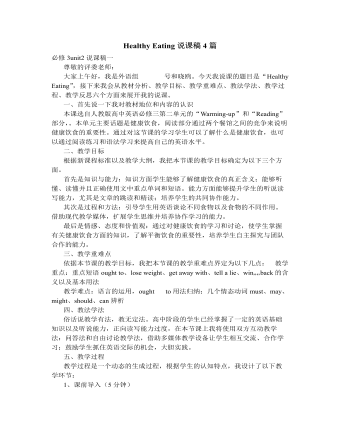
人教版高中英语必修3Healthy Eating说课稿4篇
Language learning needs a context, which can help the learners to understand the language and then can product comprehensible output, so computer has the advantages to make the materials attractive.Part 3 Learning MethodsTask-based, self-dependent and cooperative learningPart 4 Teaching ProcedureStep One Lead-in“Interest is the best teacher.” Therefore, at the very beginning of the class, I should spark the students’ mind to focus on the centre topic “the band”. I’ll show some pictures of food to attract their attention and then bring some questions.Question:What kind of food they like?What should go into a good meal?The answers must relate to the diet. After this, the students will be eager to know something about a balance diet and this is the very time to naturally lead the class into Step 2Step 2 Reading for information: skimming and scanning In this step, I use Task-based Language Teaching method, which can give students a clear and specific purpose while skimming and scanning the context.Task 1 General ideaThe students will be asked to just glance at the title and the pictures of the passage, and then guess what they will read in the text. And they’ll be divided into groups of four to have a discussion.The purpose is to inspire the students to read actively, not passively. In addition, the task is to develop the students’ reading skill by making prediction and to encourage the students to express their thoughts in English and cooperate with each other.Task 2 Main idea of each paragraphCooperative learning can raise the students’ interest and create an atmosphere of achievement. Based on this theory, I divide the whole class into 4 groups to skim the whole text and get the main idea of each paragraph.
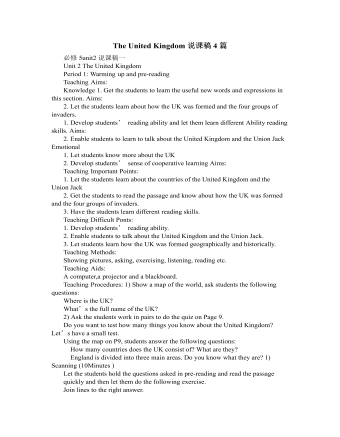
人教版高中英语必修5The United Kingdom说课稿4篇
Teaching Aims:Knowledge 1. Get the students to learn the useful new words and expressions in this section. Aims:2. Let the students learn about how the UK was formed and the four groups of invaders.1. Develop students’ reading ability and let them learn different Ability reading skills. Aims:2. Enable students to learn to talk about the United Kingdom and the Union Jack Emotional 1. Let students know more about the UK2. Develop students’ sense of cooperative learning Aims:Teaching Important Points:1. Let the students learn about the countries of the United Kingdom and the Union Jack2. Get the students to read the passage and know about how the UK was formed and the four groups of invaders.3. Have the students learn different reading skills.Teaching Difficult Ponts:1. Develop students’ reading ability.2. Enable students to talk about the United Kingdom and the Union Jack.3. Let students learn how the UK was formed geographically and historically.Teaching Methods:Showing pictures, asking, exercising, listening, reading etc.Teaching Aids:A computer,a projector and a blackboard.Teaching Procedures: 1) Show a map of the world, ask students the following questions:Where is the UK?What’s the full name of the UK?2) Ask the students work in pairs to do the quiz on Page 9.Do you want to test how many things you know about the United Kingdom? Let’s have a small test.Using the map on P9, students answer the following questions:?How many countries does the UK consist of? What are they??England is divided into three main areas. Do you know what they are? 1) Scanning (10Minutes )Let the students hold the questions asked in pre-reading and read the passagequickly and then let them do the following exercise.Join lines to the right answer.
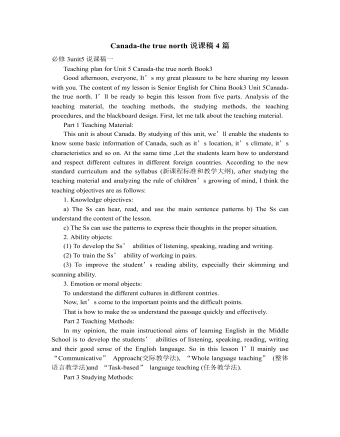
人教版高中英语必修3Canada-the true north说课稿4篇
Good afternoon, teachers, It’s my great pleasure to be here sharing my lesson with you.The content of my lesson is Senior English Book 3 Unit 5 Canada —— “The true North”.I’ll be ready to begin this lesson from five parts. Analysis of the teaching material,the teaching methods,the studying methods, the teaching procedure,and Blackboard design.First, let me talk about the teaching material.Part 1 Teaching Material:This unit is about the introduction of Canada. By studying of this unit,we’ll enable the students to learn the geography, population, main cities, and natural beauty, natural resources of Canada. Through the training of the unit, it also requires students to learn some Language skills such as the expressions of position and emotions.So it plays an important part in the English teaching in this book.After studying the teaching material and analyzing the rule of children’s growing of mind,I think the teaching aims are the followings:1.Knowledge objects:(1) make the students learn some new words and phrases(2) make the students understand the content of the lesson.2.Ability objects:(1)To develop the Ss’ abilities of listening, speaking, reading and writing. Especially reading and speaking ability.(2) learn to talk about the characters of Canada in English(3)To train the Ss’ ability of working in pairs.3.Emotion objects:(1)Enable students to understand the characters of Canada..(2)Stimulate Ss to work hard to make China stronger.Part 2 Teaching Methods:I think helping students learn to master new words and phrases and improve the students’ reading and speaking ability is import and the difficult.According to the analysis of the teaching material and the import points and the difficult points,I will use the following teaching methods : question-guiding approach; fast-reading and careful reading; multi-media teaching methods; discussion
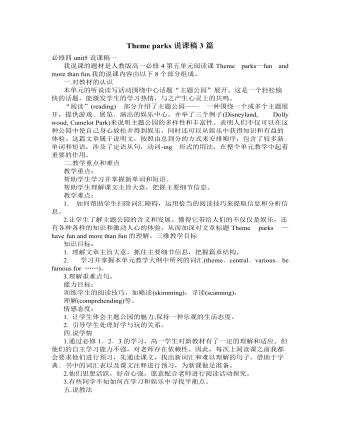
人教版高中英语必修4Theme parks说课稿3篇
The oldest and the most popular park in the worldenjoy the exciting activities thereget close to the life-size cartoon characters like Mickey Mouse and Donald Duck Step 3 Pre-reading1.What do you suppose a theme park is ?2.What do you think you can see in a theme park?(1.It is a kind of amusement park which has a certain theme – that the whole park is based on. 2.buildings, castles, statues, rare animals and birds, and so on.) Step 4 Reading ----- Theme Parks –---- Fun and More Than Fun1.Predict : Read the title and the pictures on P. 34 and PredictWhat is the meaning of the title “Theme Park – Fun and more than fun”?(The title means that theme parks are fun to visit, but that they can also be educational and can offer useful information.)2.Skimming Fast read and answer:What activities can we take in a theme park?Amusement park: Bumper car Merry-go-round slide bungee jumping Free-fall rides Horror films Pirate ship Ferris wheel roller coaster3.Scanning Read again and you will find various theme parks are mentioned in the passage . Then what are they ?Theme parks: Sports theme park History theme park Culture theme park Marine or Ocean theme Park Future park Science theme park Disneyland4.Careful reading and find the main idea of each paragraph:THEME PARKS---- entertaining/ educationalPara.1 Traditional parks are places to go for relaxation and to have time away from our busy lives.Para.2 Theme parks are different They’re large and full of things to do, see and buy.Para.3 Theme parks are built around a single idea or theme. One example is a sports park.Para.4 Another kind of theme park is historical more and cultural and can be educational.Para.5 Disneylandwas the first theme park. It is based on the fantasy life and characters of Disney’s films.Para.6 Some examples of educational theme parks include sea world parks and science parks.





















